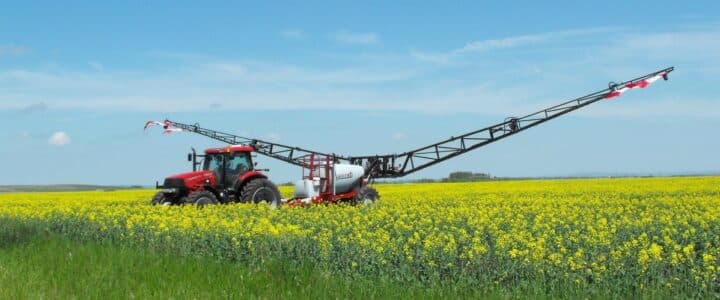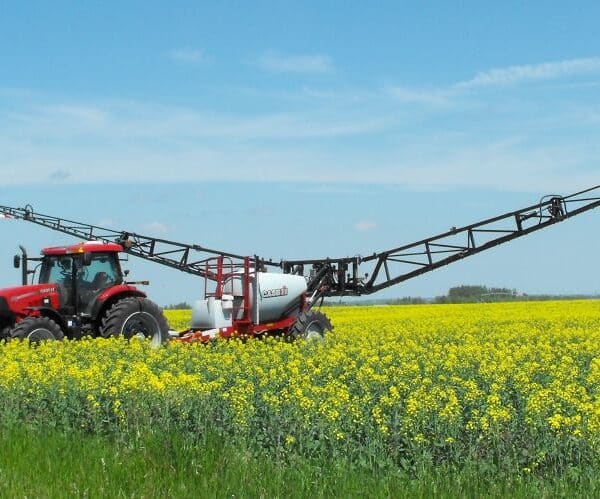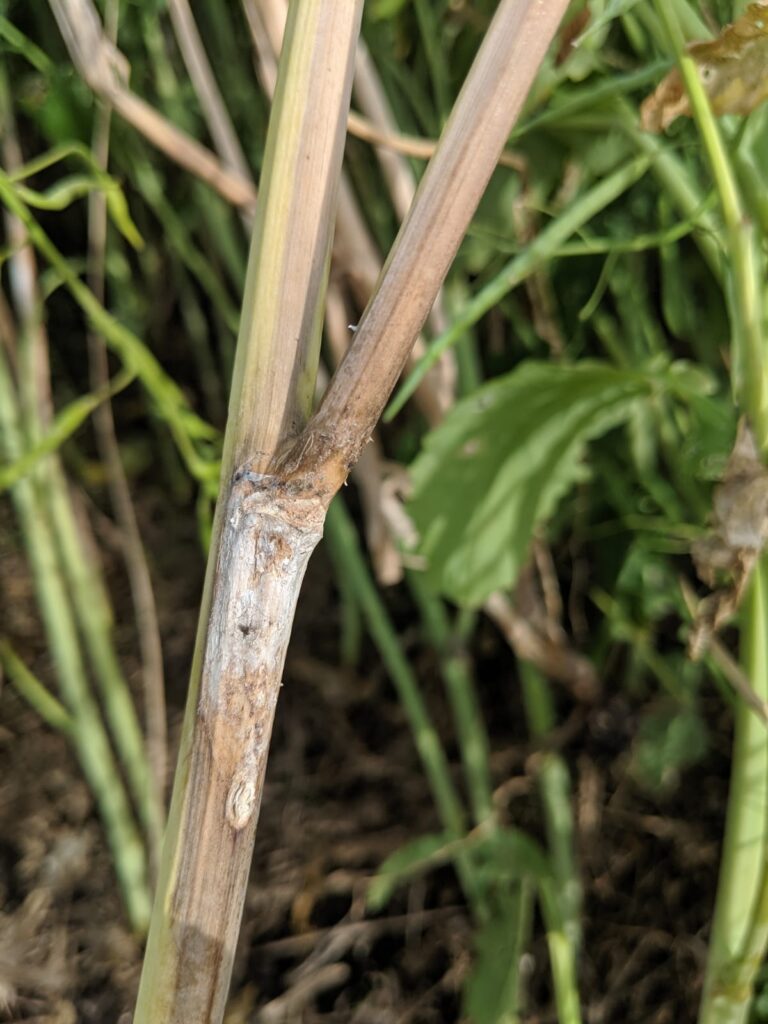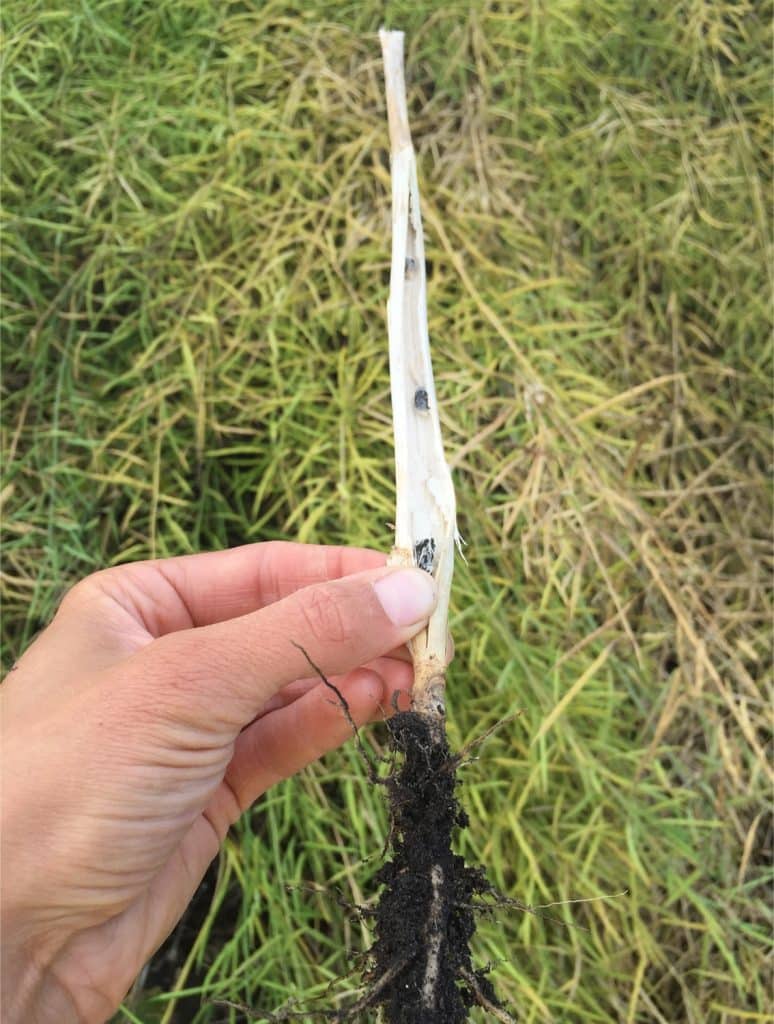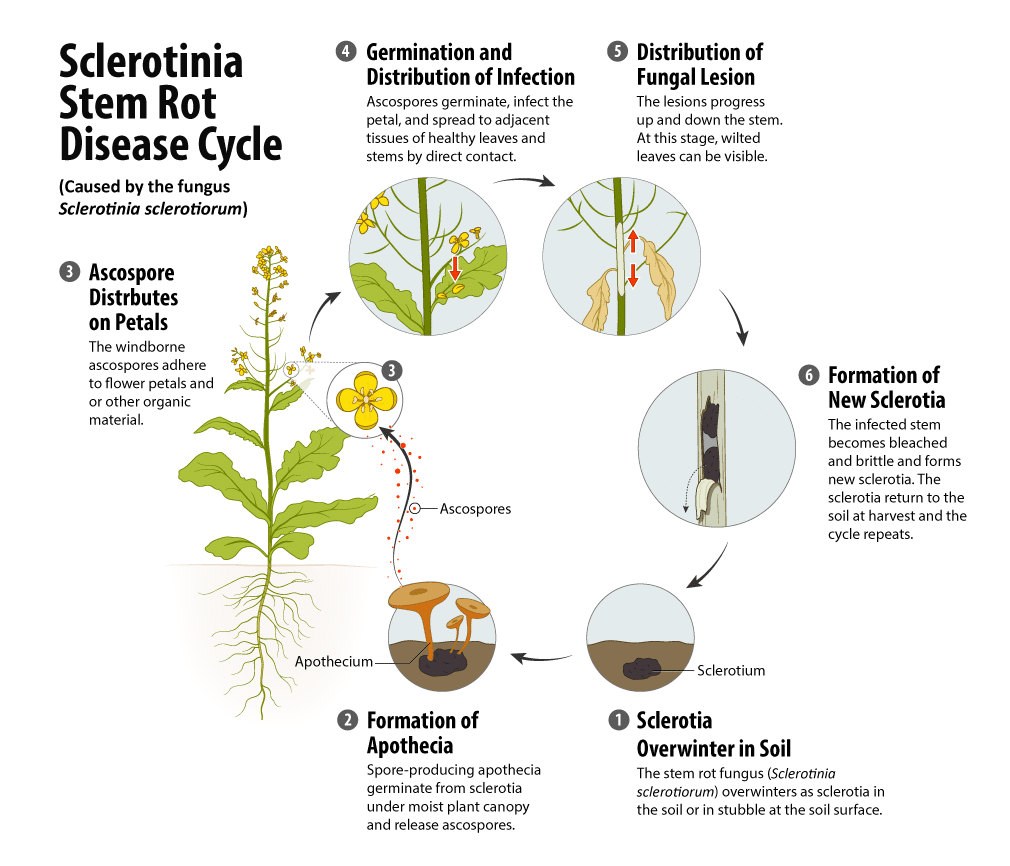Sclerotinia stem rot can cause significant damage in canola and is a challenge to predict and manage every year. However, implementing one tactic utilized in sclerotinia research could provide a huge benefit to growers over time. In addition to assessing sclerotinia risk and making that tough spray decision at the appropriate crop timing, it is equally important to go back into the crop in late summer (at 30-60% seed colour change) to rate the sclerotinia disease severity. Keeping records of both of these outcomes as well as whether the crop was sprayed or not sprayed (hopefully leaving a check strip) are key for improved long-term management of the disease. Of course, using proper scouting techniques and accurate disease identification are also needed to ensure quality records are being kept.
Importance of late season ratings
Most experiments or field trials measuring harvest seed yield only change one parameter, or treatment, at a time (ex. the variety planted, the seeding rate or seeding speed used, the fertilizer rate used), while keeping all other management practices equal. But when the treatment being tested (ex. the use or lack of use of a sclerotinia fungicide, ideally with the use of a check strip) is combined with a variable parameter, such as disease pressure, the trial becomes more challenging. This is because the disease incidence and severity varies within fields, between fields, and between years, and that variability must be measured to be accounted for. By implementing both early flower sclerotinia risk assessments and late season sclerotinia disease ratings, in addition to harvest seed yield measurements, the disease variability can be accounted for and the quality of field trial results (for growers and researchers) are improved.
Sclerotinia disease ratings for growers
Although many growers and agronomists already make early flower sclerotinia risk assessments to determine if a fungicide application is required or not, late season sclerotinia disease ratings may not always utilized (due to time constraints or other factors). By ensuring this additional field assessment is included, annual sclerotinia disease management evaluations will be more thorough and reliable. Resulting conclusions (the amount of economic loss in the field due to disease compared to the cost of an application) will also be more accurate. This will help with future sclerotinia disease management decisions (including spray decisions) and improve the long term management of this disease.
Late season sclerotinia disease ratings also allow for potential multi-year comparisons, as canola crops have different disease incidence and severity each year.
More information for growers and agronomists about on-farm trials is available in this Canola Watch fundamentals article.
Sclerotinia assessments in research trials
Late season sclerotinia disease ratings, along with other topic-specific measurements and evaluations, are also used by researchers in various projects.
Canola samples were evaluated for disease incidence and severity (prior to harvest) as well as final yields (after harvest) in Harding’s Improving sclerotinia disease control in edible beans and canola project, in order to make reliable conclusions. The assessments proved very important, as a consistent beneficial effect due to tank-mixing fungicides with micronutrients could not be confirmed in the field trials of this study due to the low disease pressure and other variables. Read more on this study here.
In order to create a sclerotinia risk model Burlakoti’s research team made early and late season assessments for the Operational models to forecast canola growth stage, sclerotinia risk, and yield in Western Canada project. The research team also recorded canola growth stages, and in-canopy and outside-canopy weather conditions during the entire growing season. In addition, they recorded sclerotinia evaluations after crop maturity before swathing and canola yield was obtained at maturity in order to successfully create and verify a sclerotinia risk model and sclerotinia score card.
Turkington’s ‘Facilitating the delivery of practical sclerotinia stem rot risk forecasts based on improved assessment of canola petal infestation’ project collected early and late bloom field samples to determine the amount of inoculum in the field – which varies by field, along with the disease risk. Final disease incidence and severity were also recorded to help determine that the developed qPCR assay is able to detect and quantify S. sclerotiorum DNA from canola petals (in the field) with a high level of sensitivity and specificity.
Implementing sclerotinia disease ratings
The best time to make sclerotinia disease ratings in canola is late in the season when the seeds are starting to fill the pods and before natural plant ripening, since the whitish sclerotinia stem lesions are more easily recognized. This is generally around the 30-60% seed colour change stage. For ideal results (and to account for variability within a field) rate 200 plants per field: 20 successive plants in a row in 10 areas of the field with uniform plant growth. It is recommended to avoid areas with damaged plants such as lodging, wheel tracks, hail, insects, birds/animals.
Each plant can be rated using this 0-5 scale, where:
- 0 = No symptoms.
- 1 = Superficial stem lesions not causing wilt.
- 2 = Lesions on stems causing premature wilt up to 25% of the plant.
- 3 = Lesions on stems causing premature wilt up to 50% of the plant.
- 4 = Lesions on stems causing premature wilt up to 75% of the plant.
- 5 = Lesions on stems causing premature wilt on more than 75% of the plant.
Then sum up each severity class and calculate the current sclerotinia disease index (SDI) using the formula below:
SDI = 100 * [ (#plants * 1) + (#plants * 2) + (#plants * 3) + (#plants * 4) + (#plants * 5) ]/(Total number of plants in the sample * 5)
Sclerotinia prediction improvements
There have been many research efforts focused on advancing sclerotinia prediction efforts and improving management of the disease.
For example, Bullock’s Weather-based assessment of sclerotinia stem rot risk project found that while weather conditions play a critical role in the timing of sclerotinia ascospore release, correlations to specify the conditions that trigger this release couldn’t be determined. The research did confirm that field history is a factor in overall disease incidence, but does not affect timing of ascospore release.
Strelkov’s ‘Development of a rapid quantitative detection method for sclerotinia stem rot inoculum to aid risk assessments and fungicide spray decisions’ project concluded that petal infestations at 40-50 per cent flower accounted for 60-92 per cent of the variation in sclerotinia stem rot incidence under field conditions in Western Canada. Interestingly, significantly higher disease infestation levels were found in afternoon (rather than morning) collected samples of young (rather than old) petals. Sclerotinia stem rot development was also influenced by environmental conditions, with relative humidity playing a more significant role in disease development than temperature.
Sclerotinia management tool in development
This summer the Canola Council of Canada is collaborating with Agriculture and Agri-Food Canada to refine a web-based sclerotinia risk assessment tool that will aim to provide more accurate sclerotinia risk evalutions and fungicide recommendations in the future. Data collected in the 2022 growing season will both improve the tool (which tentatively plans to publicly launch in 2023) and contribute to updating the algorithm used by the tool.
Volunteer beta testers are being asked to use the mobile-friendly tool in multiple canola fields two times throughout the growing season: once at early flower to measure sclerotinia risk and again at maturity to rate the sclerotinia severity (in the same fields). If you’re interested in trying out the web-based sclerotinia tool first-hand to help improve canola fungicide recommendations, email betatest@sclerotiniariskcalculator.com.
The risk assessment factors used by the tool include:
- Rainfall in last 14 days.
- Likelihood of rain in 3-day weather forecast.
- Plant density.
- Year since last host crop.
- Sclerotinia severity in last host crop.
- Estimation of sclerotia germination.
Sclerotinia management resources
See the ‘Canola disease survey recap to inform risk management in 2022‘ blog for information on 2021 sclerotinia distribution across Manitoba and Saskatchewan.
Related sclerotinia research
For more on sclerotinia stem rot research:
- Check out these completed projects on the Canola Research Hub.
- See these ongoing projects on the Canola Research Hub:
- Development of a biosensor for Sclerotinia stem rot disease forecasting in canola
- Resistance to Sclerotinia sclerotiorum effectors in canola
- Improving the management of sclerotinia stem rot of canola using fungicides and better risk assessment tools
- Biopesticides as a novel management strategy for sclerotinia in canola
- Pre-breeding lines combining canola quality with sclerotinia resistance, good agronomy and genomic diversity from PAK93
- Protection of canola from pathogenic fungi using RNA interference technologies
See a previous ‘Risk predictions and management tactics for sclerotinia stem rot’ Canola Research Hub blog for more on this canola disease.
Published July 4, 2022


